Here is my easy-peasy South Indian style coconut chutney, aka white chutney that is perfect for all the tiffins, including idli, dosa, upma, pongal, and bajjis. Don’t forget to check out the ten different variations of this vegan coconut chutney.
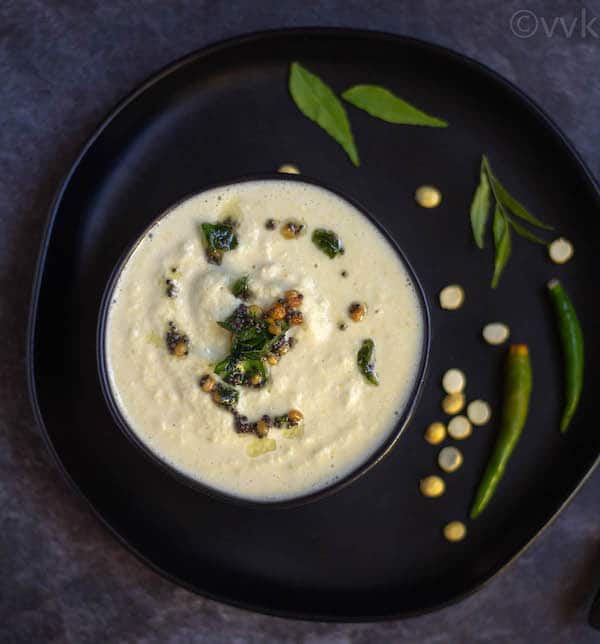
Jump to:
What is Coconut Chutney?
Coconut chutney or thengai chutney as we say in Tamil is one of the quintessential dishes in South Indian cuisine. Go to any South Indian restaurants and order idli or dosa or pongal or any tiffin (light meal/snacks) items; you will see coconut chutney served as a side dish along with sambar.
Call it white chutney or coconut chutney for tiffins; you can make this chutney in less than 15 minutes. No, I am not kidding. Even if you grate the coconut from scratch, it’s not going to take more than 15 to 20 minutes maximum. That’s how easy the chutney is and guess what; it is vegan, and you can make it gluten-free as well.
Believe it or not, I make this chutney atleast thrice in a week. But it has taken me this long to post it on the blog. Sometimes we ignore the basic recipes, and I have a long list of that. In 2020, you will see more South Indian kitchen staples and simple dishes like this coconut chutney.
How to Make Coconut Chutney?
It’s effortless. It requires only two steps.
- Grind the coconut, roasted gram, green chili and salt with water. Add water as required while grinding.
- Temper the chutney.
That’s all. No need to saute or roast the ingredients.
Frozen Coconut Or Fresh Coconut?
Nothing can beat the taste of fresh coconut, but if you can’t source fresh coconut or if time is pressing for grating the coconut, then go for a frozen one. I prefer the shredded/grated frozen coconut than the sliced ones. Shredded comes in handy for South Indian stir-fry or poriyals also.
I haven’t tried this recipe with unsweetened desiccated coconut.
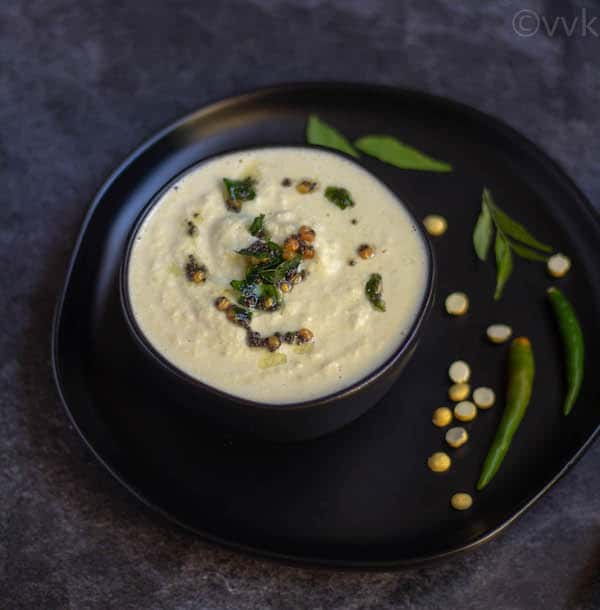
Coconut Chutney Variations:
Like every other recipe, every household has their version of coconut chutney. And today, I am sharing the very basic version. But as mentioned before, here are the ten different variations.
Just by adding one or two ingredients, you will get a whole new flavorful chutney. Every variation deserves a new post, but while I work on that, let me share it quickly here too.
You can make different kinds of coconut chutney, and the variations are endless. But I am limiting myself here to 10 different varieties.
Note – the base measure stays the same for all these variations ie, 1 cup of coconut and ½ cup of pottukadalai/roasted gram. I follow a 1:2 ratio of dal to coconut.
1) Adding Tamarind:
In our household, we don’t add tamarind to coconut chutney. But you can add 1 tsp of tamarind paste or a small betel nut size of tamarind pod for this measure. It adds a subtle tangy flavor to the chutney.
2) Adding Shallots:
You can add one or two shallots or small onions to this chutney, and it adds a whole new flavor profile.
3) Adding Garlic:
If you like the raw taste of garlic, you can add 2 to 3 small garlic cloves for this measure. You can also combine shallots and garlic. One of each would do for this measure.
4) Adding Cilantro:
You can add 2 tbsp to 4 tbsps of chopped cilantro for fresh flavor. But it changes the color of the chutney, and it’s no longer the white chutney. :-) You can also add curry leaves. I personally don’t prefer adding fresh mint to coconut chutney. I always saute the mint leaves.
5) Adding Ginger:
You can also add a 1-inch piece of fresh ginger along with green chilies.
6) Adding dried red chilies:
Instead of green chilies, you can add two or three dried red chilies. Again, that changes the color of the chutney. You can also add one green chili and one dried red chili.
7) Without Roasted Gram:
You can skip roasted gram for pure white chutney. In this case, either increase the coconut amount or reduce the green chili and salt amount according to your preference.
8) With Desi Split Chickpeas or Chana Dal:
Instead of the roasted gram, you can also add chana dal. But you need to roast it first. I would say ¼ cup of chana would be sufficient for this measure. If you are using chana dal, then add dried chilies instead of green. The combo works well. Dry roast the chana dal and red chilies until the chana dal turns light brown and then grind it along with coconut and salt with water.
9) With Almonds & Walnuts:
You can skip roasted gram and use almonds or walnuts. If you are using almonds, blanch them first and remove the skin. 10 to 15 almonds or walnuts would be sufficient for this measure. You can use roasted peanuts too.
10) Tempering with Different Oil:
For this recipe, I used neutral corn oil. But if you temper it with coconut oil or sesame oil, it changes the taste profile. Also, while tempering, you can add crushed garlic or shallots for enhanced flavor.
Getti Chutney:
Getti chutney is a variation to the coconut chutney, but it earns its own spot. Let me explain why?
Getti is a Tamil word meaning thick. And when we say getti chutney, it means thick coconut chutney. Getti chutney unanimously refers to coconut chutney.
It’s quite popular in restaurants, especially for the to-go orders. Back in those days, we take our vessels when we order to-go food for liquid items. The restaurants pack the thick/solid food in banana leaf, and then it is wrapped in a newspaper. Isn’t it the best eco-friendly way? No plastic papers, boxes, or covers.
It is still the same in roadside restaurants and small scale restaurants. They prefer thick chutney as it doesn’t ooze out, and they pack it along with the idli or dosa or upma. I don’t have a picture of how they pack, but it’s on my to-do list. Next time during my India trip, I will take a picture and share it here.
Now back to the getti chutney. It’s the same coconut chutney but with less water. For this base measure, I would add ¼ cup + 2 tbsp. That’s it :-) I would recommend adding a garlic clove or shallot for the restaurant-style taste. Isn’t simple? Try it out.
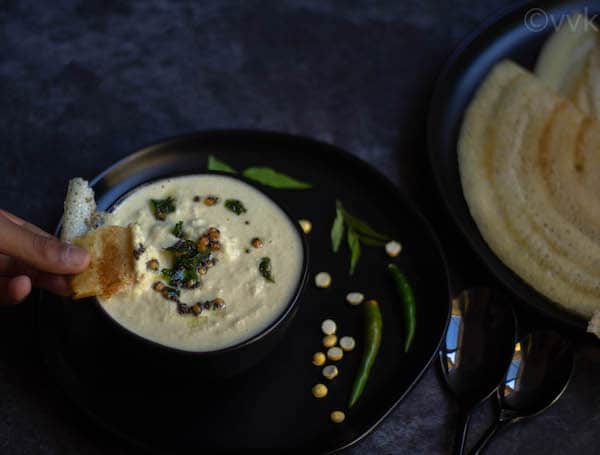
Now before getting into the coconut chutney recipe, here are some things to consider about the ingredients.
Recipe Notes-
- You can use fresh or frozen coconut for this chutney. I always use frozen shredded/grated coconut for this. I don’t buy the frozen coconut slices.
- If you are using fresh coconut while grinding, make sure you are not grating the brown part of the coconut. Just grate the white part for pure white coconut chutney. You can also reduce the amount of roasted gram/pottukadalai. Roasted gram adds a tint of yellow to the chutney.
- If you are using frozen coconut, make sure you thaw it to room temperature. You can use the microwave to thaw it, but ensure the coconut is not hot while grinding. If the coconut is too cold or hot, it secretes the oil, and you can find the oily layer on the chutney. Room temperature coconut works best for this recipe.
- I used roasted split chickpeas, and if you are using the whole ones, add only ¼ cup.
- Adjust the salt to taste and green chilies according to your preference. And for the green chilies alternative, please check my coconut chutney variations.
- I prefer little thin consistency chutney for my idli, upma, and pongal. So I always grind the chutney with ½ cup of water and rinse the jar with ½ more cup of water and add it to the chutney. But for dosa, I prefer slightly thick. So I grind it with ½ cup of water but while rinsing the mixer jar, 3 to 4 tbsps of water only. Cleaning the mixer jar with water is entirely optional. You need at the max ½ cup of water to grind this chutney. So adjust accordingly.
- Skip asafoetida to make it gluten-free. While tempering, you can add cumin seeds too.
Storage Tips
Coconut chutney’s shelf-life is short when compared to other ingredients. I would recommend using this chutney within a day. But if you want to refrigerate, make sure to refrigerate in an air-tight container. Make sure you use clean spoons for each serving.
Do not reheat the chutney. Also, take the required quantity before each serving and refrigerate the rest right away. In this way, it stays fresh. I won’t suggest storing it beyond three days. In that case, you can freeze.
Honestly, given the fact that you can make this chutney in less than 15 minutes, I would recommend making it fresh as required.
Other Chutney Recipes:
If you like this coconut chutney, then don’t forget to check out my dry coconut chutney for rice, toor dal chutney for rice, and also green mango chutney. You can also find all my chutney recipes here in the chutney category.
Now without any further ado, here is the coconut chutney recipe.
- In a blender or a mixer jar, add the coconut, roasted gram, green chilies, and salt.

- Without adding any water, grind the ingredients. It will be in a coarse consistency like below. As coconut contains a little moisture, grinding it without water helps to blend all the ingredients.
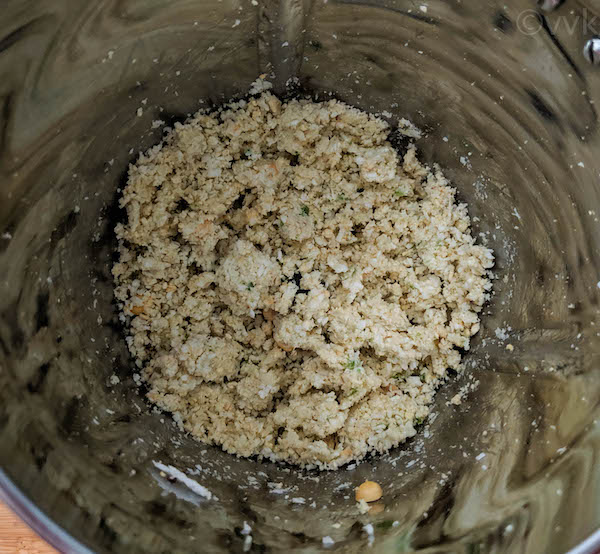
- Now add ¼ cup of water and grind it. And it will look like a blob as shown in the picture. (PS: If you want thick chutney/getti chutney, add one or two tbsps of water at this stage and grind it and take out the chutney from the jar.)
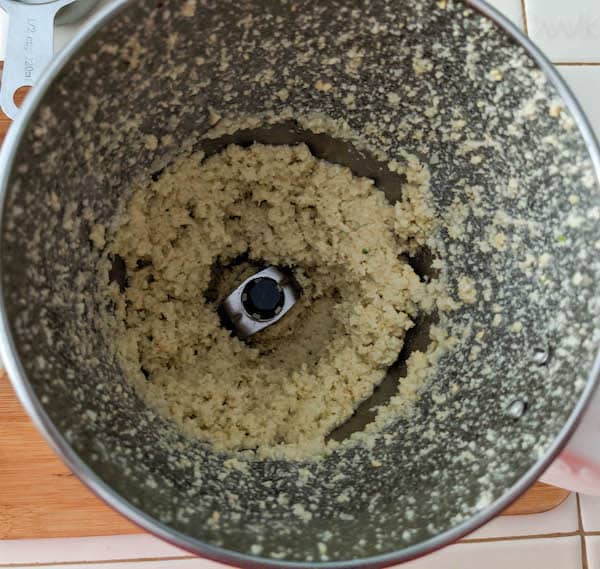
- Now add ¼ more cup of water and blend it nicely into a smooth chutney.
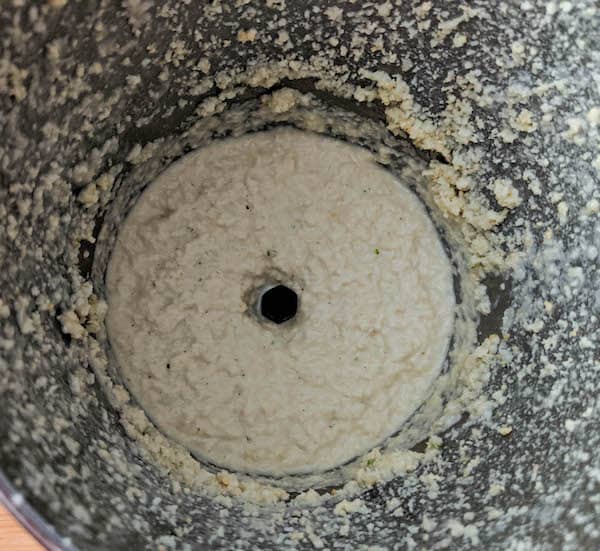
- Transfer the chutney to a bowl and rinse the mixer jar with ¼ or ¼ cup of water and add it to the chutney.
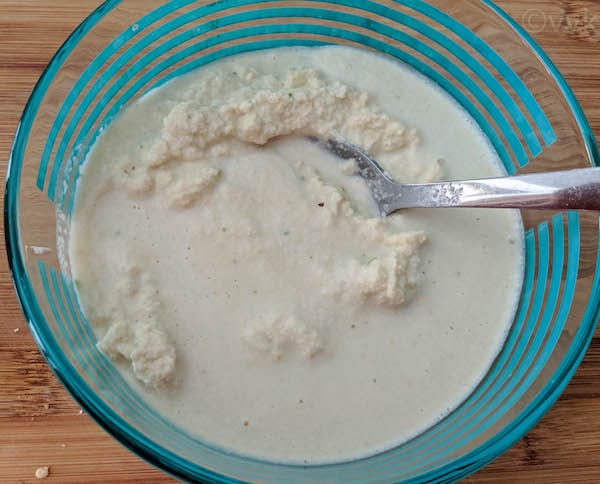
- And mix well. Adjust the water according to your consistency preference.
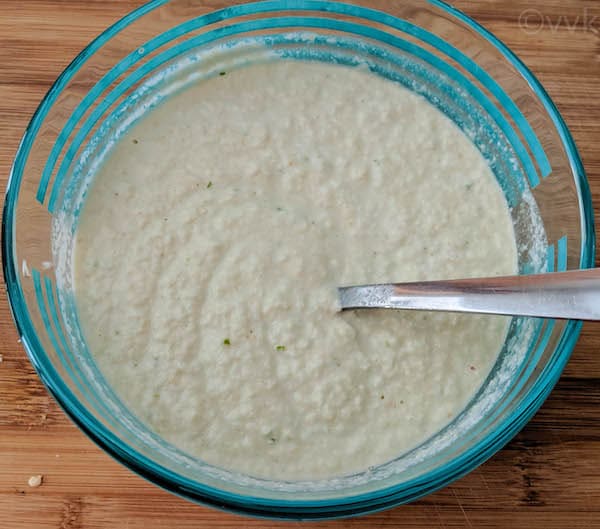
- Now in a separate tempering pan, heat the oil over medium heat.
- When the oil is hot, add the mustard seeds, urad dal, chana dal, curry leaves, and hing.
- As the mustard seeds start to sputter, turn off the heat and add it to the chutney. Mix well.
- Serve it with idli, dosa, upma, pongal, rava khichdi, semiya khichdi, vada, pakora, and many other dishes.
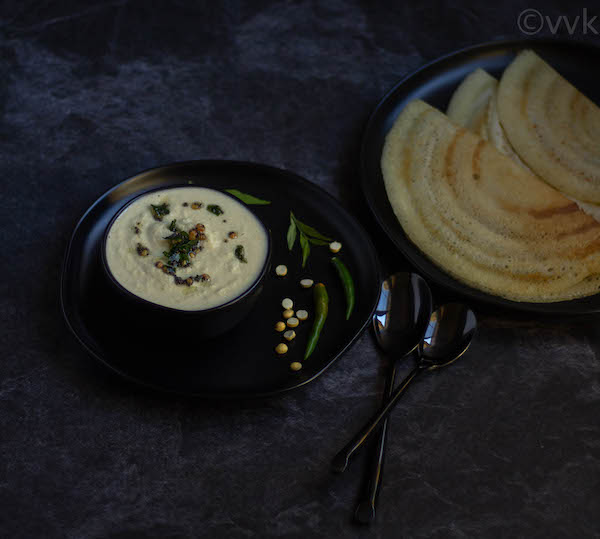
Frequently asked questions
We make coconut chutney with coconut, roasted gram / fried gram (pottukadalai), green chilies, salt, and water.
How do you preserve coconut chutney?
As we are using coconut, I highly recommend refrigerating it and using clean spoons for each serving. Alternatively, you can also freeze it for longer shelf life.
You can enjoy coconut chutney with idli, dosa, upma, ven pongal, and snacks like pakora, bajji, etc.
We consume coconut daily, and that said, if you love coconut chutney, you can have it frequently. We typically make this chutney, or its variation, atleast thrice or four times a week.
PS: Follow me on Instagram or join my Facebook Group for more gardening and recipe updates. If you try this coconut chutney, please don’t forget to comment and rate this recipe. If you have any questions, please leave a comment, and I will get to it asap. Make sure to follow me on my Pinterest for more healthy and delicious ideas!
📖 Recipe
Coconut Chutney | South Indian Style White Coconut Chutney
Equipment
- Blender or Mixie
Ingredients
To Grind:
- 1 cup coconut grated
- ½ cup roasted gram pottukadalai
- 2 green chilies broken into two pieces
- 1 tsp salt
- 1 cup water ¾ to 1 cup, as required
To Temper:
- 2 tsp oil
- ½ tsp mustard seeds
- ½ tsp urad dal
- ½ tsp chana dal
- 5 curry leaves
- ¼ tsp hing
Instructions
- In a blender or a mixer jar, add the coconut, roasted gram, green chilies, and salt.
- Without adding any water, grind the ingredients. It will be in a coarse consistency like below. As coconut contains a little moisture, grinding it without water helps to blend all the ingredients.
- Now add ¼ cup of water and grind it. And it will look like a blob as shown in the picture. (PS: If you want thick chutney/getti chutney, add one or two tbsps of water at this stage and grind it and take out the chutney from the jar.)
- Now add ¼ more cup of water and blend it nicely.
- Transfer the chutney to a bowl and rinse the mixer jar with ¼ or ¼ cup of water and add it to the chutney and mix well. Adjust the water according to your consistency preference.
- Now in a separate tempering pan, heat the oil over medium heat.
- When the oil is hot, add the mustard seeds, urad dal, chana dal, curry leaves, and hing.
- As the mustard seeds start to sputter, turn off the heat and add it to the chutney. Mix well.
- Serve it with idli, dosa, upma, pongal, rava khichdi, semiya khichdi, vada, pakora, and many other dishes.
Notes
- You can use fresh or frozen coconut for this chutney. I always use frozen shredded/grated coconut for this. I don’t buy the frozen coconut slices.
- If you are using fresh coconut while grinding, make sure you are not grating the brown part of the coconut. Just grate the white part for pure white coconut chutney. You can also reduce the amount of roasted gram/pottukadalai. Roasted gram adds a tint of yellow to the chutney.
- If you are using frozen coconut, make sure you thaw it to room temperature. If you are using the microwave to thaw it, ensure the coconut is not hot while grinding. If the coconut is too cold or hot, it secretes the oil, and you can find the oily layer on the chutney. Room temperature coconut works best for this recipe.
- I used roasted split chickpeas, and if you are using the whole ones, add only ¼ cup.
- Adjust the salt and green chilies according to your preference. And for the green chilies alternative, please check my coconut chutney variations.
- I prefer little thin consistency chutney for my idli, upma, and pongal. So I always grind the chutney with ½ cup of water and rinse the jar with ½ more cup of water and add it to the chutney. But for dosa, I prefer slightly thick. So I grind it with ½ cup of water but while rinsing the mixer jar, 3 to 4 tbsps of water only.
- Cleaning the mixer jar with water is entirely optional. You need at the max ½ cup of water to grind this chutney. So adjust accordingly.
- Skip asafoetida to make it gluten-free.
Nutrition
I am not a nutritionist. The nutritional information is provided as a courtesy and is an estimate only. It varies depending upon the product types or brands.
Update Notes: Earlier posted this recipe in 2014. I have updated the recipe with new pictures and variations.



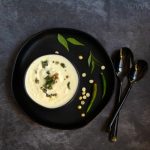

Great, simple and easy method to learn. Thanks for sharing this.
Thanks.
I am from kolkata dear … thank you so much for your recipe in detail. .. and very happy to know the variations. .. I have a doubt about the chutney … if I make this 6 o’clock in the morning and want to send it to my daughter’s tiffin. .. how long it will stay fresh in a school bag … pls reply … thanks in advance
During summer, it’s quite difficult, especially with the weather. Try it keeping it in an insulated bag. That should help.
Great, simple and easy method to learn.
Thanks :-)
Thank you for the simple and easy recipe.
You could have included Peanut chutney too.
Thanks. I have peanut chutney as a separate recipe. So I didn’t include in this post.